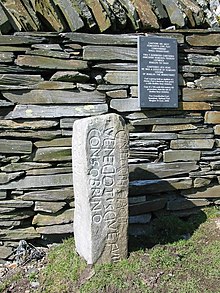Cantiorix Inscription

TheCantiorix Inscriptionis a stone grave marker of the earlypost-Roman erafound nearFfestiniogin northWalesand now at the church atPenmachno.It is notable both as the first known historical reference to theKingdom of Gwynedd,and for its use of theRomanterms for 'citizen' and 'magistrate'.
It is considered by some to be evidence that a Roman-style administration existed beyond theRoman departure from Britainin some form in the early Kingdom of Gwynedd, while others either question or discount its significance in that regard.
Inscription
[edit]John Rhyshad read the Latin text as "Cantiori Hic Jacit Venedotis Cive Fuit Consobrino Magli Magistrati" in hisLectures on Welsh Philology(1877), noting that "the person commemorated was a man of importance, and a Venedotian citizen, whatever that may exactly mean".[1]Thomas Charles-Edwardswas more precise inAfter Rome(2003), noting technical details such as an all-capitals text and the use of late spoken Latin (e.g., CIVE instead of the formally correct CIVIS) to date the inscription to the fifth or sixth century, and neither before nor after that. He translated the inscription as "Cantiori lies here; he was a citizen of Gwynedd, a cousin of Maglus the magistrate", adding his broader thesis that "As well as the language, the political discourse of the Empire survived".[2]
Background
[edit]The Cantiorix stone was found near Ffestiniog at the site traditionally known as the 'Graves of the Men of Ardudwy' (Welsh:Beddau Gwŷr Ardudwy). The site has been destroyed over time, with little but the Roman road now visible. Antiquarian accounts include references to "likely long-cist graves marked by upright stones, suggesting a cemetery, as well as cairns, stones and other remains, which are thought to have included burial monuments of prehistoric date."[3]
Treatment by historians
[edit]The importance of the reference to early medieval Gwynedd is uncontested, but the implications of the inscription's use of the terms 'civis' and 'magistrate' is varied. Rhys expressed doubt as to the inscription's meaning of 'civis', while Charles-Edwards suggested that it was evidence of a Roman-style "political discourse" inearly medieval northern Wales.
Lloydin hisHistory of Wales(1911) mentions the inscription stone at Penmachno as an early reference to Gwynedd (Venedotisbeing a genitive form of something likeVenedas) in the sixth or seventh century and cites references, but does not comment upon it further. His discussion of "Wales Under Roman Rule" does not support any notion of a Roman heritage of administration or society, stating that Welsh society kept its native structure and connections to its pre-Roman past.[4]
Wendy Daviesin herWales in the Early Middle Ages(1982) mentions the Cantiorix inscription parenthetically as part of a comment on people and communities. She says generally that there is very occasional mention ofcives(citizens) as members of the community, and this single inscription is the only occurrence where it is mentioned in a context that specifies the size and nature of the community—a citizen of Gwynedd.[5]
John Daviesin hisHistory of Wales(1990) mentions several of the inscription stones at Penmachno, noting the reference to a "citizen of Gwynedd", and relates them to a desire to cling to the Roman world, particularly regarding trade goods, but does not otherwise relate them to a survival of a Roman-originated administration.[6]
Snyder,speaking of the Cantiorix inscription in hisAge of Tyrants(1998), notes that the termmagistratusis "otherwise unknown to British Christian epigraphy, though civic antecedents can be found on contemporary inscriptions fromGauland the Mediterranean "and discusses several ancient usages of the term. He also notes authorities who had reached conclusions to the contrary, such asAlcock's belief thatmagistratusreferred to one of the survivingcivitatesleaders to whomHonoriushad sent his rescript in 410, andNash-Williams' belief that the inscription was evidence of an ordered system of government in north Wales in the post-Roman era, centered uponSegontium.Snyder also questions the meaning of a "citizen of Venidos", saying that Gwynedd at this time was a region that would later become a kingdom, and was not a city.[7]
Edwards in herEarly-Medieval Inscribed Stones and Stone Sculpture in Wales(2001) notes that the inscription recalls terms of the Roman past and suggests possible context (e.g., the Roman custom of burials along roads), also noting that the inscription stone from Castell Dwyran inCarmarthenshirecontains the wordProtictoris,a title recalling a Roman past.[8]
Citations
[edit]- ^Rhys 1877:168Lectures on Welsh Philology,Lecture IV. The inscription is mentioned again in the Appendix on page 387 with the text as-written:Cantiori Hic Jacit Venedotis Cive Fuit [C]onsobrino Ma[g]li Magistrati.
- ^Charles-Edwards 2003:9After Rome: c.400-c.800,Introduction (Fifth Century Britain).
- ^Edwards 2001:25Early-Medieval Inscribed Stones and Stone Sculpture in Wales
- ^Lloyd 1911:40, 89History of Wales.Reference to the inscription stone is made on page 40. He states on page 89 that Welsh society kept its native structure and connections to its past.
- ^Davies 1982:82Wales in the Early Middle Ages.
- ^Davies 1990:54–55History of Wales
- ^Snyder 1998:118–119Age of Tyrants
- ^Edwards 2001:27–28Early-Medieval Inscribed Stones and Stone Sculpture in Wales
References
[edit]- Charles-Edwards, Thomas(2003), Charles-Edwards, Thomas (ed.),After Rome: c.400-c.800,New York: Oxford University Press,ISBN978-0-19-924982-4
- Davies, John(1990),A History of Wales(First ed.), London: Penguin Group (published 1993),ISBN0-7139-9098-8
- Davies, Wendy(1982),Wales in the Early Middle Ages,Leicester: Leicester University Press,ISBN0-7185-1235-9
- Edwards, Nancy(2001), "Early-Medieval Inscribed Stones and Stone Sculpture in Wales: Context and Function",Medieval Archaeology(PDF),vol. 45, pp. 15–39,doi:10.1179/med.2001.45.1.15,S2CID162335191

- Lloyd, John Edward(1911),A History of Wales from the Earliest Times to the Edwardian Conquest,vol. I (2nd ed.), London: Longmans, Green, and Co (published 1912)
- Rhys, John(1877),Lectures on Welsh Philology,London: Trübner & Co.
- Snyder, Christopher A.(1998),An Age of Tyrants: Britain and the Britons A.D. 400–600,University Park: Pennsylvania State University Press,ISBN0-271-01780-5
